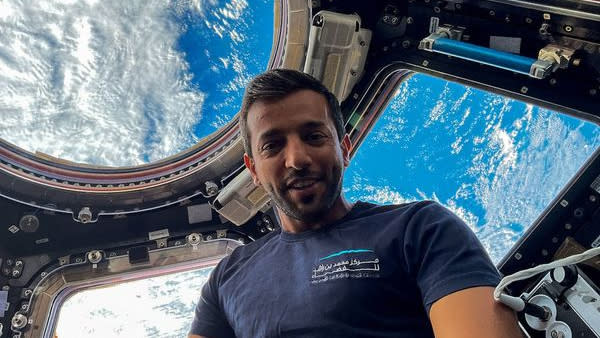UAE's 1st long-duration astronaut says a moon mission is within reach
- Oops!Something went wrong.Please try again later.

The United Arab Emirates' (UAE's) first astronaut to spend a long time in space says it's quite possible his country will fly humans further from Earth.
Sultan Al Neyadi spoke Tuesday (Sept. 12) about his record-breaking six-month flight to the International Space Station. He told Space.com he hopes the UAE Space Agency will also get to the moon with NASA's Artemis program.
"The UAE has signed the Artemis Accords, and hopefully will be part of it in the future," Al Neyadi told Space.com of moon exploration during a press conference from NASA's Johnson Space Center in Houston, livestreamed on NASA Television. (The accords both include countries intending to fly to the moon with NASA, and countries pledging peaceful space exploration norms aligned with the agency.)
Also on the SpaceX Crew-6 flight with Al Neyadi was an international crew: NASA astronauts Warren "Woody" Hoburg and Stephen Bowen, and Andrey Fedyaev of Russian space agency Roscosmos. The crew safely returned to Earth on Sept. 6, splashing down in the Atlantic Ocean aboard their SpaceX Crew Dragon.
Related: UAE's 1st long-duration astronaut celebrates Eid in space to end Ramadan
Al Neyadi has been a pioneering UAE astronaut. His region just named the first two astronauts in 2018, and only one other person from that area (Hazzaa Ali Almansoori) has flown to space before him, for a short stay.
Al Neyadi set two key milestones on his own mission, becoming the first person from the UAE to spend a long-duration mission in space, and performing the first spacewalk. Among other memorable moments: Al Neyadi was the first person to practice jiu jitsu in space — and the purple belt holder displayed his microgravity martial art prowess in a six-minute video on X, formerly Twitter.
While he noted he would like to fly to space again, Al Neyadi also pointed to the three other citizens from the UAE who could go: Almansoori, and December 2021 astronaut candidate class members Mohammad Al Mulla and Nora Al Matrooshi.
"We have astronauts under training that will be finished next year," he said. "It's a continuation of human spaceflight. I'm happy to be part of it, and the UAE is committed to going further into space."
Crew-6's stay of 180 days is typical of space station crews, but commander Steve Bowen, who flew three flights during the space shuttle era, said that shorter-duration missions may become more common as the space station evolves.
Related Stories:
— NASA astronaut Loral O'Hara ready for Soyuz launch to relieve delayed crew in space
— NASA astronaut Frank Rubio surprised by his accidental record in space (video)
— The International Space Station: Facts, history and tracking
"You get really highly trained, and you execute the choreography, and you get it done," he said about shorter missions during the same press conference, adding that longer duration spaceflights have their own intensity. While tasks are not as tightly scheduled during these lengthier missions, the "changes you see in your body" create alterations along the way, he said.
"I think each of these models really has their place going forward," Bowen said of long-duration and short-duration missions. He hinted that in the far future, space missions could last years.
"Other than whaling ships back in the 19th century, we really don't have a human model to emulate (long durations) with," he added. "That's a lot of learning we have to do before we get there."
